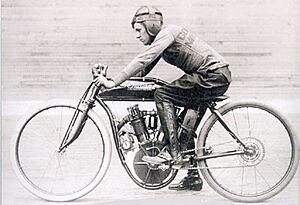Eddie Hasha facts for kids
Quick facts for kids Eddie Hasha |
|
|---|---|

Hasha racing at Newark Motordrome in 1912
|
|
| Nationality | |
| Born | 1890, Waco, Texas |
| Died | (aged 21-22) Newark Motordrome, Newark, New Jersey |
| Years active | 1911–1912 |
Eddie Hasha (born around 1890 – died September 8, 1912) was an American motorcycle racer. He was famous for racing on special tracks made of wood, called "board tracks," in the early 1900s. People called him the "Texas Cyclone" because he was from Waco, Texas. His tragic death helped lead to the end of these dangerous board tracks.
Eddie Hasha's Racing Career
Eddie Hasha started his racing journey in 1911 in Denver. He rode a powerful Indian motorcycle. In May 1911, he set an amazing record. He reached a speed of 95 miles per hour (153 kilometers per hour) at the motordrome in Playa del Rey, California. This was a new record for the mile distance.
In 1912, Eddie became even more famous. He beat all the top racers at the Los Angeles Motordrome. He set new professional records there. After these wins, he moved his racing from the western United States to the east.
At one point, Hasha took a short break from racing. He worked at a Harley-Davidson motorcycle shop in Dallas. He was good friends with Arthur Davidson, who helped start Harley-Davidson. Arthur even lent Eddie a racing motorcycle for a race in 1910. Eddie won that race in Waco, Texas. But soon after, he returned to motorcycle racing.
The Tragic Accident
On September 8, 1912, Eddie Hasha was racing at the Newark Motordrome in Newark, New Jersey. About 5,000 people were there to watch. After the main race, he joined a five-mile handicap race. Five other riders were in this race, including Ray Seymour, who held a world record.
Eddie and Ray were the only riders without a handicap. The other four riders started one lap ahead. Eddie was slightly in the lead after the first lap. On the third lap, Eddie's motorcycle started having problems. He reached down to fix something. Ray Seymour then passed him.
Eddie sped up to catch Ray. He was going about 92 miles per hour (148 kilometers per hour). Suddenly, Eddie's motorcycle sharply turned into the rail around the track. The bike rode along the rail for about 100 feet (30 meters). This terrible accident instantly killed Eddie Hasha. Sadly, it also caused the deaths of several people watching from the stands. Another racer, Johnny Albright, was hit by the riderless motorcycle. He later passed away from his injuries.
The crowd became very scared. Many people were injured as they tried to get away. It took more than an hour to clear the grandstands. Medics from all over the city came to help the injured.
How the Accident Changed Racing
Eddie Hasha's death was so important that it was on the front page of The New York Times newspaper. The Newark Motordrome had just opened on July 4 of that year. After the accident, it was closed forever and never reopened.
These deaths made people compare board track racing to Roman gladiatorial contests. People started calling the short board tracks "murderdromes." Because of the dangers, many of these tracks began to close down.

